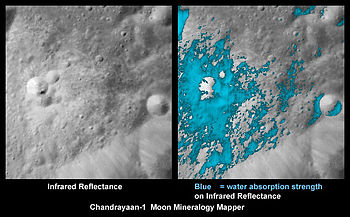

Lunar water is water that is present on the Moon. The search for the presence of lunar water has attracted considerable attention and motivated several recent lunar missions, largely because of water's usefulness in making long-term lunar habitation feasible.[1]
The moon was believed to be completely dry after analysis of Apollo mission soil samples; it was understood that any water vapor on the surface would generally be decomposed by sunlight, leaving hydrogen and oxygen lost to outer space. However, subsequent robotic probes found evidence of water, especially of water ice in some permanently-shadowed craters on the Moon; and in 2018 water ice was confirmed in multiple locations.[2][3][4][5] This water ice is not in the form of sheets of ice on the surface nor just under the surface, but there may be small (less than about 10 centimetres (3.9 in)) chunks of ice mixed into the regolith, and some water is chemically bonded with minerals.[6][7][8] Other experiments have detected water molecules in the negligible lunar atmosphere,[9] and even some in low concentrations at the Moon's sunlit surface.[10]
Water (H2O) and the related hydroxyl group (-OH) exist in forms chemically bonded as hydrates and hydroxides to lunar minerals (rather than free water), and evidence strongly suggests that this is the case in low concentrations for much of the Moon's surface.[11][12] In fact, of surface matter, adsorbed water is calculated to exist at trace concentrations of 10 to 1000 parts per million.[13]
Water may have been delivered to the Moon over geological timescales by the regular bombardment of water-bearing comets, asteroids, and meteoroids[14] or continuously produced in situ by the hydrogen ions (protons) of the solar wind impacting oxygen-bearing minerals.[15]
NASA's Ice-Mining Experiment-1 (set to launch on the PRIME-1 mission no earlier than late 2024) is intended to answer whether or not water ice is present in usable quantities in the southern polar region.[16]
- ^ "The Moon". nssdc.gsfc.nasa.gov. Retrieved 2022-07-07.
- ^ Water and Ices on the Moon", science.nasa.gov, fetched 11 June 2024
- ^ "Ice Confirmed at the Moon's Poles". NASA Jet Propulsion Laboratory (JPL). Retrieved 2023-04-13.
- ^ Water on the Moon: Direct evidence from Chandrayaan-1's Moon Impact Probe. Published on 2010/04/07.
- ^ Pinson, Jerald (2020-11-20). "Moon May Hold Billions of Tons of Subterranean Ice at Its Poles". Eos. 101. doi:10.1029/2020eo151889. ISSN 2324-9250. S2CID 229487508.
- ^ Akhmanova, M; Dement'ev, B; Markov, M (February 1978). "Water in the regolith of Mare Crisium (Luna-24)?". Geokhimiya (in Russian) (285).
- ^ Akhmanova, M; Dement'ev, B; Markov, M (1978). "Possible Water in Luna 24 Regolith from the Sea of Crises". Geochemistry International. 15 (166).
- ^ Pieters, C. M.; Goswami, J. N.; Clark, R. N.; Annadurai, M.; Boardman, J.; Buratti, B.; Combe, J. -P.; Dyar, M. D.; Green, R.; Head, J. W.; Hibbitts, C.; Hicks, M.; Isaacson, P.; Klima, R.; Kramer, G.; Kumar, S.; Livo, E.; Lundeen, S.; Malaret, E.; McCord, T.; Mustard, J.; Nettles, J.; Petro, N.; Runyon, C.; Staid, M.; Sunshine, J.; Taylor, L. A.; Tompkins, S.; Varanasi, P. (2009). "Character and Spatial Distribution of OH/H2O on the Surface of the Moon Seen by M3 on Chandrayaan-1". Science. 326 (5952): 568–572. Bibcode:2009Sci...326..568P. doi:10.1126/science.1178658. PMID 19779151. S2CID 447133.
- ^ "Is There an Atmosphere on the Moon? | NASA". nasa.gov. 7 June 2013. Retrieved 2015-05-25.
- ^ "NASA - SOFIA discovers water on sunlit surface of the Moon". NASA. 26 October 2020.
- ^ Lucey, Paul G. (23 October 2009). "A Lunar Waterworld". Science. 326 (5952): 531–532. Bibcode:2009Sci...326..531L. doi:10.1126/science.1181471. PMID 19779147. S2CID 642214.
- ^ "NASA's SOFIA Discovers Water on Sunlit Surface of Moon". NASA. 26 October 2020. Retrieved 26 October 2020.
- ^ Clark, Roger N. (23 October 2009). "Detection of Adsorbed Water and Hydroxyl on the Moon". Science. 326 (5952): 562–564. Bibcode:2009Sci...326..562C. doi:10.1126/science.1178105. PMID 19779152. S2CID 34849454.
- ^ Elston, D.P. (1968) "Character and Geologic Habitat of Potential Deposits of Water, Carbon and Rare Gases on the Moon", Geological Problems in Lunar and Planetary Research, Proceedings of AAS/IAP Symposium, AAS Science and Technology Series, Supplement to Advances in the Astronautical Sciences., p. 441
- ^ "NASA – Lunar Prospector". lunar.arc.nasa.gov. Archived from the original on 2016-09-14. Retrieved 2015-05-25.
- ^ "NASA - NSSDCA - Spacecraft - Details".